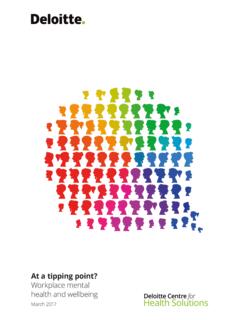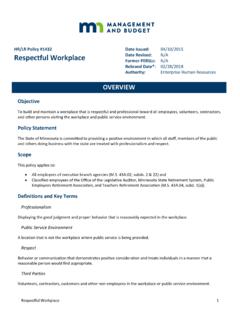Transcription of Psychological Well-Being in the Workplace Stress ...
1 Stress management Interventions: Improving Subjective Psychological Well-Being in the Workplace By Holman, D., Johnson, S., & O'Connor, E., University of Manchester Citation: Holman, D., Johnson, S., & O'Connor, E. (2018). Stress management interventions: Improving subjective Psychological Well-Being in the Workplace . In E. Diener, S. Oishi, & L. Tay (Eds.), Handbook of Well-Being . Salt Lake City, UT: DEF Publishers. Abstract: In this chapter we provide an overview of Stress management interventions (SMI) and review the evidence for their effects on employee Stress and Well-Being . We start by setting out a typology of SMI that classes SMI according to level ( , the individual-level or organisation-level) and focus ( , a primary' focus on altering the causes of Stress or a secondary' or tertiary' focus on reducing Stress itself).
2 We then use this typology to describe key types of SMI, after which we review the evidence for those SMI with the most extensive evidence bases, namely secondary individual-level SMI that seek to reduce Stress in employees ( , relaxation techniques, cognitive-behavioral therapy, mindfulness training) and primary organisational-level SMI that seek to remove the causes of Stress by changing organisational practices ( , job redesign, changes to working time schedules). We conclude by suggesting that there is convincing evidence for both of these SMI approaches. However, the evidence base needs strengthening through more robust methodological designs ( , randomised control trials, broad based evaluations of intervention processes) and a better understanding of the contexts and individuals in which SMIs are most effective, how the implementation of SMIs affects outcomes, and the long-term impacts of Keywords: Stress management interventions, evaluation, review, cognitive-behavioral therapy, mindfulness training, job redesign Improving employee Well-Being and reducing Stress can have a number of benefits for organizations, from increasing performance, improving relationships, to reducing sickness and absenteeism rates (De Neve, Diener, Tay & Xuereb, 2013; Warr, 2003).
3 Stress management interventions refer to a class of activities that are used by organizations to improve employee Well-Being and reduce Stress , principally by either addressing the causes of Stress or by reducing the impact of Stress on an individual. The aim of this chapter is to review the literature on Stress management interventions to establish what we know about the effectiveness of different interventions in improving Psychological Well-Being . It is split into three main sections. First, we introduce a typology of Stress management interventions (SMI) and provide examples of the different types of intervention. Second, we discuss the evidence concerning the effectiveness of SMI, although before this we will briefly discuss methodological considerations used when evaluating interventions to provide the reader with some grounds for understanding the quality of evidence in this area.
4 Finally, we conclude the chapter with an overview of what works best. When reviewing the literature, we use a broad definition of subjective Psychological Well-Being which enables us to include studies on burnout, anxiety, and depression, for example, as well as studies focusing directly on positive Psychological Well-Being . Furthermore, as we are interested in Psychological Well-Being we do not include studies that have looked at physical health or job attitudes, or those on well- being related outcomes at the organizational-level such as sickness and absenteeism. However, it is worth noting that these outcomes are related such that improvements in Psychological Well-Being can lead to improvements in health, job satisfaction and absenteeism rates. Stress management Interventions: A Typology and Description 1.
5 The Stress management literature typically classifies interventions according to the focus' of Stress management and according to the level' at which the intervention takes place (DeFrank & Cooper, 1987;. de Jonge & Dollard, 2002). With regard to the focus of Stress management , interventions are categorized as primary, secondary or tertiary. The aim of primary interventions is to prevent Stress from occurring by removing the sources of Stress and enhancing the causes of Well-Being . Secondary interventions aim to reduce the severity or duration of Stress once it has occurred and to prevent the level of Stress becoming problematic. Tertiary interventions seek to rehabilitate and maximize functioning for those who are already experiencing or suffering from Psychological ill-health.
6 With regard to the level of an intervention, a common and simple distinction is between individual and organizational levels. As the name suggests, individual-level interventions focus on helping employees to develop skills to manage, cope with and reduce Stress , whereas organizational-level interventions make more systemic changes to organizational practices that either target all employees or a specific group of workers. A third category, individual-organizational level interventions, is used in some classifications. Such interventions are thought to differ from others in that they focus on changing the relationship between the individual and organization, , peer support groups. However, as the distinction between organizational and individual-organizational level interventions is not always clear cut, we use the more parsimonious categorization of individual-level and organizational-level interventions.
7 Classifying Stress management interventions (SMI) according to their focus and level implies that both individual and organizational-level interventions can be primary, secondary and tertiary in nature. This is illustrated in Table 1, along with examples of the different types of intervention in each category. Throughout the remainder of the chapter we describe the different types of SMI according to this classification. Table 1. A Typology of Stress management Interventions Intervention Individual Organisational type Primary Selection & Assessment Job Redesign Pre-employment medical examination Working time and schedules management training, mentoring Secondary Mindfulness training Improving communication and decision making Health promotion, , exercise Conflict management Cognitive behavioral therapy Peer support groups Relaxation Coaching & career planning Meditation Personal and interpersonal skill training Acceptance and commitment therapy Psychosocial intervention training Coping skills training Resilience training Tertiary Employee Assistance Programmes Vocational rehabilitation Counselling Outplacement Posttraumatic Stress assistance Disability management Individual-Level Interventions The aim of a primary individual-level intervention is to prevent Stress from occurring in an employee.
8 One means of achieving this is through selection and assessment procedures that select applicants who have the skills and abilities to manage the demands of the job and to screen out those who might be susceptible to experiencing Stress in the target role, particularly in highly-stressful occupations (Bartone, Roland, Picano & Williams, 2008). Although such interventions are one way of managing Stress and promoting Well-Being , they are rarely used (Giga, Cooper & Faragher, 2003). 2. Secondary individual-level interventions seek to equip employees with the skills and abilities to manage Stress and promote Well-Being , and to provide employees with opportunities to engage in Stress - reducing activities. They include techniques such as relaxation, meditation, cognitive behavioural therapy, mindfulness training, and exercise programmes, as well as other techniques such as education and interpersonal skill development.
9 Drawing on the emotion regulation literature (Gross, 1998), these techniques can be understood as promoting antecedent-focused emotion regulation strategies that seek to reduce or remove the causes of Stress , or response-focused emotion regulation strategies that seek to reduce the level of Stress experienced by individuals. It can also be noted that some individual-level interventions are multimodal, , a combination of relaxation, CBT and mindfulness exercises. Such an approach might be used in the expectation that it will increase the likelihood of beneficial outcomes for both the individual and organization, as it can enable employees to develop a wide set of skills that can be used across different circumstances, provide employees with the opportunity to develop both antecedent and response-focused emotion regulation strategies, and increase the chance of meeting employees' needs.
10 As secondary individual interventions are one of the more commonly used SMI, and there is a stronger evidence base for their effectiveness (which we outline later), we now detail the more widely used techniques. Relaxation techniques are based on the assumption that states of relaxation and Stress ( , highly- aroused negative states of Well-Being such as anxiety, tension and anger) are antithetical (Russell, 1979). In other words, you cannot be both relaxed and stressed at the same time, such that increasing levels of relaxation will necessarily entail lower levels of Stress . Various methods are used to induce relaxation but all can be considered as response-focused emotion regulation strategies as they focus on reducing the symptoms of Stress . Progressive muscle relaxation involves tensing and then relaxing different muscles throughout the body in a prescribed order.


